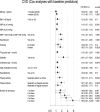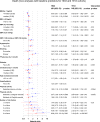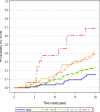Although Coronary Mortality Has Decreased, Rates of Cardiovascular Disease Remain High: 21 Years of Follow-Up Comparing Cohorts of Men Born in 1913 With Men Born in 1943
- PMID: 29674335
- PMCID: PMC6015276
- DOI: 10.1161/JAHA.118.008769
Although Coronary Mortality Has Decreased, Rates of Cardiovascular Disease Remain High: 21 Years of Follow-Up Comparing Cohorts of Men Born in 1913 With Men Born in 1943
Abstract
Background: Despite a decline in mortality rates from cardiovascular disease (CVD) in the past few decades, the burden of CVD in a contemporary population remains inadequately addressed. Therefore, this study was aimed to investigate secular trends in mortality from coronary artery disease and all-cause mortality over 2 decades, by comparing 2 cohorts of men born 30 years apart and evaluate the prediction of the risk of CVD and all-cause death in a contemporary random sample of Swedish men.
Methods and results: Two cohorts of randomly selected men born in 1913 (855 men) and 1943 (798 men) were first examined at age 50 in 1963 and 1993, respectively, and followed longitudinally over 21 years. All-cause mortality and coronary artery disease death were lower in 50- to 71-year-old men born in 1943 compared with those born in 1913, with unadjusted hazard ratios of 0.57 (0.45-0.71) and 0.34 (0.22-0.53), respectively. After adjustment for risk factors (smoking, serum cholesterol, hypertension, systolic blood pressure, diabetes mellitus, body mass index, and physical activity), the differences between the cohorts remained significant for coronary artery disease, hazard ratios 0.57 (0.34-0.94), P=0.029, but not for all-cause mortality hazard ratios 0.82 (0.62-1.07), P=0.14. However, the rate of CVD events during follow-up was still high (30.7%) for the men born in 1943. No statistically significant interaction by birth cohort in contribution of risk factors to death was found between 2 cohorts except physical inactivity.
Conclusions: Despite a marked reduction in the rate of coronary artery disease death over the past 30 years, the burden of CVD events and all-cause mortality remains high. Therefore, intensified efforts to modify contributing risk factors are still required.
Keywords: cardiovascular disease; death; longitudinal cohort study; population studies; risk factor.
© 2018 The Authors. Published on behalf of the American Heart Association, Inc., by Wiley.
Figures







References
-
- Kesteloot H, Sans S, Kromhout D. Dynamics of cardiovascular and all‐cause mortality in Western and Eastern Europe between 1970 and 2000. Eur Heart J. 2006;27:107–113. - PubMed
-
- Björck L, Rosengren A, Bennett K, Lappas G, Capewell S. Modelling the decreasing coronary heart disease mortality in Sweden between 1986 and 2002. Eur Heart J. 2009;30:1046–1056. - PubMed
-
- Ford ES, Ajani UA, Croft JB, Critchley JA, Labarthe DR, Kottke TE, Giles WH, Capewell S. Explaining the decrease in U.S. deaths from coronary disease, 1980–2000. N Engl J Med. 2007;356:2388–2398. - PubMed
Publication types
MeSH terms
LinkOut - more resources
Full Text Sources
Other Literature Sources
Miscellaneous

